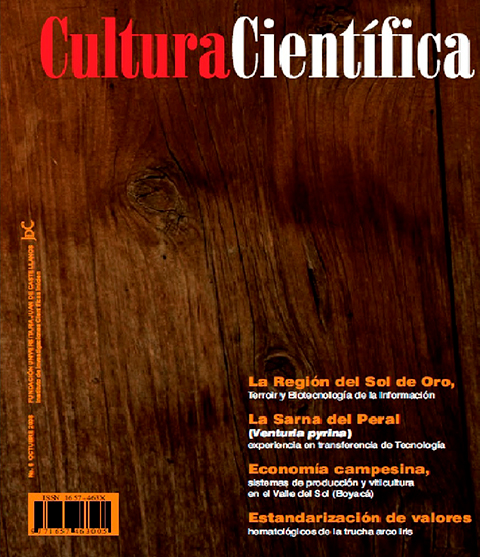Keywords:
growth, development, physiology, bocashi, boilAbstract
This work was directed to evaluate the lulo´s (Solanum quitoense Lam. var. septentrionale) physiologic answer. They were used three treatments with organic fertilization (bocashi, bocashi + biol mix and biol), and a forth one with chemical synthesis (18-18-18), using the description of physical and physiological variables to establish the plant´s optimum development and growth during three time-intervals. Three sampling were made at various physiological stages of the plant selecting a plant for each plot. The physical analyzed variables were dry biomass foliar area, and the physiological variables were index of foliar area, growth rate, relative growth rate and net assimilation rate. It was used a design of full blocks at random with variance analysis and proof of Duncan. The results in dry mass were highly significant, whereas in the physiological variables there were no differences. In all treatments the best response was given by the implementation of chemical synthesis fertilizer, followed by the mixture of bocashi + bioll, which was the most economical.
Downloads
References
AZ CON–BIETO, J. y TALÓ N, M. 1993. Fisiología y bioquímica vegetal. Editorial Mc Graw-Hill Interamericana, Madrid. 581 p.
BARRAZA, F., FISCHER, G. y CARDONA, C. 2004. Estudio del proceso de crecimiento del cultivo de tomate (Lycopersicon esculentum Mill) en el Valle del Sinú medio, Colombia. Agronomía Colombiana 22 (1), 32-39 p.
CASIERRA -POSADA, F., GAR CÍA, E. y LÜDDERS, P. 2004. Determinación del punto óptimo de cosecha en el lulo (Solanum quitoense Lam. var. Quitoense y septentrionale). Agronomía Colombiana 22 (1), 32-39 p.
CORPORACIÓN COLOMBIA INTERNACIONAL (CCI). 2006. Perfil del producto, inteligencia de mercados: lulo. En: http://www.cci.org.co, 15 p.; consulta: septiembre de 2008.
CHAPARRO, A. y OROZ CO, M. 1995. Fisiología vegetal práctica. Departamento de Biología, Facultad de Ciencias, Universidad Nacional de Colombia, Bogotá. Guía de laboratorio. 2 p.
DEPARTAMENTO ADMINISTRATIVO NACIONAL DE ESTA DÍSTICA (DANE). 2004. I Censo Nacional de 10 Frutas Agroindustriales y Promisorias. Bogotá. 305 p.
DEFILI PIS, C., PAR ÍAN, S. y JIMÉNEZ, A. 2003. Caracterización del crecimiento de plantines de Brassica rapa var. Pequinensis en contenedores. Universidad Nacional de Lujan, Argentina. http://www.unlu.edu.arg/riego/plantines%20brassica-2003jct.doc; consulta: junio de 2008.
FOGG, G. 1967. El crecimiento de las plantas. Editorial Universitaria de Buenos Aires (EUDEBA). 327 p.
GAR CÍA, F. 2006. Interacción entre microorganismos, estructura del suelo y nutrición vegetal. EN: Cultura Científica. FUJC. Tunja. 48–55 p.
GOMEZ, C., BUITRAGO, C., CANTE, M. y HUERTA S, B. 1999. Ecofisiología de papa (Solanum tuberosum) utilizada para consumo fresco y para la industria. Revista Comalfi 26 (1–3), 42–55 p.
HUY SKENS-KEIL, S., PRO NO-WIDAYART, H., SCHREINER, M. y LU DDERS, P. 2001. Effect of surface coating and film packing on the keeping quality of solanaceous crops (Solanum muricatum Ait, Solanum quitoense Lam). Acta Hort. 553, 621-625 p.
HUNT, R. 2003. Plant growth analysis: individual plants. En: Thomas, B., D. Morphy y D. Murria (eds.). Encyclopaedia of Applied Plant Sciences. Academic Press, London. 579–588 p.
__________________ 1982. Plant growth curves. The functional approach to plant growth analysis. Edward Arnold Publishers Ltd., Londres. 67 p.
INSTITUTO GEOGR ÁFICO AGU STÍN CODAZZI. 1998. Diccionario Geográfico de Colombia. Tomo 4.
JARMA, A., BUITRAGO, C. y GUTI ERR EZ, S. 1999. Respuesta del crecimiento de la habichuela (Phaseolus vulgaris L. var. Blue lake) a tres niveles de radiación incidente. Revista Comalfi 26 (1-3), 62–73 p.
JARMA, A., RENGI FO, T. y ARA MÉNDIZ, H. 2006. Fisiología de la estevia (Stevia rebaudiana L.) en función de la radiación en el caribe colombiano. II análisis de crecimiento. Agronomía Colombiana 24 (1), 56–67 p.
MORALES, J., LÓPEZ, F., PÉREZ, G., RÍOS, G., ECHEVERRI, D. y MURILLO, M. 2002. Evaluación agroeconómica del cultivo del lulo (Solanum quitoense Lam.) en la región central cafetera de Colombia. 319-325. En: Giraldo, M.J. y J.P. Higuera. (eds.). Memorias IV Seminario de Frutales de Clima Frío Moderado. Corpoica, Universidad Pontificia Bolivariana, Centro de Desarrollo Tecnológico de Frutales, Medellín.
MÚNERA, G. 2002. Nemátodos asociados con el cultivo del lulo. 135-141 p. En: Giraldo, M. y J. Higuera (eds.). Memorias IV Seminario de Frutales de Clima Frío Moderado. Corpoica, Universidad Pontificia Bolivariana, Centro de Desarrollo Tecnológico de Frutales, Medellín.
PEREZ, J. 2000. Cultivo II - Hortalizas y Frutales, Universidad Nacional Abierta y a Distancia, Bogotá. 737-751 p.
PINEDA, H. 2000. Evaluación del comportamiento agronómico de diez cultivares de tomate (Lycopersicum esculentum Mill.) en las condiciones de Roldanillo (Valle del Cauca). Trabajo de grado. Facultad de Agronomía, Universidad Nacional de Colombia, Bogotá. 73 p.
RESTR EPO, J. 2000. Elaboración de abonos orgánicos fermentados y biofertilizantes foliares. Experiencias con agricultores de Mesoamérica y Brasil. Instituto Interamericano de Cooperación para la Agricultura. San José, Costa Rica. 155 p.
SALISBURY, F. y ROSS, C. 2000. Fisiología de las plantas 3. Desarrollo de las plantas y fisiología ambiental. Thomsom Editors, Madrid (España). 529-599 p.
TORRES, A. 2002. Inteligencia de mercados para lulo, mora y uchuva. 326-330 p. En: Giraldo, M.J. y J.P. Higuera. (eds.). Memorias IV Seminario de frutales de clima frío moderado. Corpoica. Universidad Pontificia Bolivariana, Centro de Desarrollo Tecnológico de Frutales, Medellín.
URIBE, F. 1991. Botánica general. Universidad de Antioquia, Medellín. 264 p.





